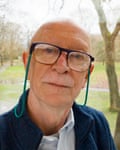Guildford School of Art had a good reputation for photojournalism, but when I got there, I found there were no photojournalists on the staff. You just had to get on with it yourself. During my final year, I photographed the 1968 anti-Vietnam war demo outside the US Embassy in London. I learned on the job.
There was a lot of dissatisfaction, so when I found out there was going to be a meeting of students to discuss asking to improve things, I went along. It soon became clear that not only did the students believe the place needed a shakeup, many of the staff felt the same way. However, the governors refused to take us seriously. In those days, these places were run by local councillors who had no feeling for the young or for the arts. When we suggested they were the wrong people to be running it, we were just informed: “Do what you’re told, we’re in charge.” It was clear we needed to make a stand, and that’s how the sit-in began.
You can see the attitude we were up against in another one of the photographs I took, where the Vice-Principal is addressing students who have taken over the canteen. His stance and jabbing finger speak volumes. By week four, in an attempt to get the governors to take us seriously, we’d occupied the whole building. The sit-in continued for eight weeks, even longer than the similar protest at Hornsey College of Art in London. By the end, the school was entirely shut down, the electricity had been cut off and the board of governors were unsuccessfully applying for an order from the High Court to have us evicted.
Throughout it all, I kept taking pictures. Students were often up talking all night and sleeping wherever they could. I discovered these two in the graphic design studio one morning, asleep in their camp beds. In those days you valued your 36 frames, and I think this is the only shot I took of them. I didn’t know who they were and still don’t. A lot of us are still in touch, though, and even had a big get-together and an exhibition 50 years after the sit-in.
Two or three months before our final assessment, we’d had to say what was going to be our major piece of work. Mine was pretty mundane. When the sit-in started, I thought: “This is a ton more interesting.” It was a national event which I was in the middle of. The art school was supposed to have trained me to be entrepreneurial, to see an opportunity and grab it. “Well,” I thought. “That’s exactly what I’ve done.”
So I submitted pictures of the sit-in, half knowing the school wouldn’t be happy. And I was right: they refused to give me any kind of qualification, which didn’t please my dad, I must say. But the following year, photos I had taken of Summerhill, teacher AS Neill’s democratic school in Suffolk, were published as a Penguin Education Special with a text by children’s writer Leila Berg. I gave my dad a copy and he took it to show his mates in the pub, proud as punch.
As a boy from a council estate, the art school environment was a shock at first and the sit-in was eye-opening. It ended without the governors ever agreeing to a useful dialogue with us, but soon afterwards the minister for education insisted that all schools, colleges and universities must invite students and staff on to their advisory boards. That we have that today is a direct result of those art school sit-ins.
Nowadays I do a lot of work around copyright infringement, trying to ensure photographers get paid for unauthorised use of their work. I learned back then that if something isn’t as it should be, then say so – and I’m still doing that at 76. You might make yourself unpopular, but you can look back and think: “Well, that was worth doing.”
John Walmsley’s CV
Born: Harrow, Middlesex, 1947
Trained: “Three years at Guildford School of Art (1965-68), denied any qualification”
Influences: “The early documentary photographers who could capture those life moments as they were without seeming to influence them.”
High point: “Most recently, taking a GCSE photography student into the print room at the National Portrait Gallery to see the pictures of mine in the collection. Afterwards, curator Clare Freestone very kindly gave us a personal tour of the Yevonde exhibition”
Low point: “Realising that so many publishers would now rather copy or use someone’s photos without asking or paying. How a young photographer is supposed to make a living is beyond me. Trying to find a budget to get my archive digitised is also proving a major headache.”
Top tip: “Ask questions, talk to people and listen to what they say”

